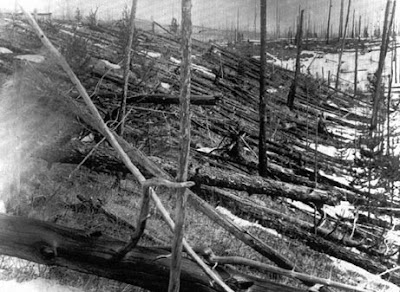
The crater was discovered under a lake near the Podkamennaya Tunguska River in western Siberia, where the cataclysm, known as the Tunguska event, took place on June 30, 1908, a ball of fire exploded about 6 miles (10 kilometers) above the ground in the sparsely populated region, scientists say. The blast released 15 megatons of energy—about a thousand times that of the atomic bomb dropped on Hiroshima—and flattened 770 square miles (2,000 square kilometers) of forest. Since then many teams of scientists have combed the site, but none was able to find any fragments of an object, like a rocky asteroid or a comet, that might have caused the event. In their new study, a team of Italian scientists used acoustic imagery to investigate the bottom of Lake Cheko, about five miles (eight kilometers) north of the explosion's suspected epicenter. "When our expedition [was at] Tunguska, we didn't have a clue that Lake Cheko might fill a crater," said Luca Gasperini, a geologist with the Marine Science Institute in Bologna who led the study. "We searched its bottom looking for extraterrestrial particles trapped in the mud. We mapped the basin and took samples. As we examined the data, we couldn't believe what they were suggesting. "The funnel-like shape of the basin and samples from its sedimentary deposits suggest that the lake fills an impact crater," Gasperini said.
The basin of Lake Cheko is not circular, deep, and steep like a typical impact crater, the scientists say. Instead it's elongated and shallow, about 1,640 feet (500 meters) long with a maximum depth of only 165 feet (50 meters). Gasperini's team says that the basin's unusual shape is the result of a fragment thrown from the Tunguska explosion that plowed into the ground, leaving a long, trenchlike depression. "We suggest that a 10-meter-wide [33-foot-wide] fragment of the object escaped the explosion and kept going in the same direction. It was relatively slow, about 1 kilometer a second [0.6 mile a second]," Gasperini said. The lake is located along the most probable track of the cosmic body, he added, which likely made a "soft crash" in the marshy terrain. "It splashed on the soft, swampy soil and melted the underlying permafrost layer, releasing CO2 [carbon dioxide], water vapor, and methane that broadened the hole, hence the shape and size of the basin, unusual for an impact crater. "Our hypothesis is the only one that accounts for the funnel-like morphology of Lake Cheko's bottom," he added. In a previous expedition, Russian scientists studied Lake Cheko and concluded that it had formed before 1908, indicating that it was not formed by the Tunguska event. The team had measured sediments on the bottom of the lake and determined that the deposits were accumulating there at about 0.4 inch (1 centimeter) a year. This suggested that Lake Cheko was several centuries old. But Gasperini's team argues that the older deposits found by the Russians were already there when the explosion took place. "We found evidence that only the topmost, one-meter-deep [three-foot-deep] layer of debris actually came from the inflowing river," Gasperini said. "[The] deeper sediments are deposits that predate 1908. They were the target over which the impact took place, so Lake Cheko is only one century old." The team's findings are based on a 1999 expedition to Tunguska and appeared in the August issue of the journal Terra Nova.





